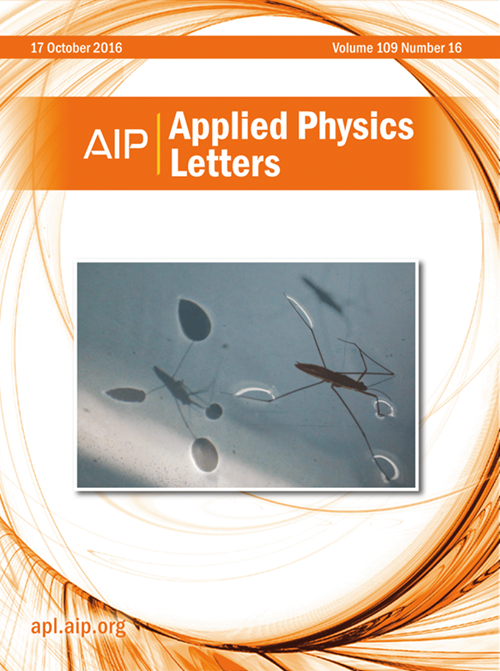具有强层间激子发射的(BA)2PbI4/WSe2异质结构的Van der Waals外延
IF 3.6
2区 物理与天体物理
Q2 PHYSICS, APPLIED
引用次数: 0
摘要
范德华(vdW)外延实现了二维(2D)钙钛矿异质结构中定制的激子相互作用和电荷分离,解决了光电集成挑战。利用两步化学气相沉积工艺,在第二次生长过程中,通过控制BAI蒸汽的引入,将单层WSe2上预沉积的PbI2层转化为(BA)2PbI4,克服了有机配体迁移率低和PbI2蒸汽压有限导致的(BA)2PbI4形成的挑战。该方法促进了纳米片和厚度可调(BA)2PbI4纳米膜的生长,实现了层间强耦合,如在83 K下的显性层间激子(IX)发射所证明的那样。值得注意的是,外延异质结构的层间耦合系数为纳米片的0.75和纳米膜的0.65,优于转移异质结构,突出了vdW外延在提高界面激子相互作用和结构精度方面的优势。此外,外延生长(BA)2PbI4/WSe2样品的激光诱导IX发射蓝移高达111 meV,证实了优越的激子相互作用和耦合强度。这些发现证明了vdW外延集成有机二维钙钛矿与TMDCs的可行性,建立了这种异质结构对探索IX物理的结构和光学意义。本文章由计算机程序翻译,如有差异,请以英文原文为准。
Van der Waals epitaxy of (BA)2PbI4/WSe2 heterostructures with strong interlayer exciton emission
Van der Waals (vdW) epitaxy enables tailored excitonic interactions and charge separation in two-dimensional (2D) perovskite heterostructures, addressing optoelectronic integration challenges. Utilizing a two-step chemical vapor deposition process, pre-deposited PbI2 layers on monolayer WSe2 are transformed to (BA)2PbI4 by controlled introducing of BAI vapor during the second growth, overcoming challenges of (BA)2PbI4 formation caused by low organic ligand mobility and limited PbI2 vapor pressure. This method facilitates the growth of nanosheets and thickness-tunable (BA)2PbI4 nanofilm, achieving strong interlayer coupling as evidenced by dominant interlayer exciton (IX) emissions at 83 K. Notably, epitaxial heterostructures exhibit interlayer coupling coefficients of 0.75 for nanosheets and 0.65 for nanofilm, outperforming transferred heterostructures and highlighting the advantage of the vdW epitaxy in improving interfacial exciton interactions and structural precision. Additionally, laser-induced IX emission blue shifts up to 111 meV in epitaxial grown (BA)2PbI4/WSe2 samples, confirming superior excitonic interactions and coupling strength. These findings demonstrate the feasibility of vdW epitaxy for integrating organic 2D perovskites with TMDCs, establishing the structural and optical significance of such heterostructures for exploring IX physics.
求助全文
通过发布文献求助,成功后即可免费获取论文全文。
去求助
来源期刊

Applied Physics Letters
物理-物理:应用
CiteScore
6.40
自引率
10.00%
发文量
1821
审稿时长
1.6 months
期刊介绍:
Applied Physics Letters (APL) features concise, up-to-date reports on significant new findings in applied physics. Emphasizing rapid dissemination of key data and new physical insights, APL offers prompt publication of new experimental and theoretical papers reporting applications of physics phenomena to all branches of science, engineering, and modern technology.
In addition to regular articles, the journal also publishes invited Fast Track, Perspectives, and in-depth Editorials which report on cutting-edge areas in applied physics.
APL Perspectives are forward-looking invited letters which highlight recent developments or discoveries. Emphasis is placed on very recent developments, potentially disruptive technologies, open questions and possible solutions. They also include a mini-roadmap detailing where the community should direct efforts in order for the phenomena to be viable for application and the challenges associated with meeting that performance threshold. Perspectives are characterized by personal viewpoints and opinions of recognized experts in the field.
Fast Track articles are invited original research articles that report results that are particularly novel and important or provide a significant advancement in an emerging field. Because of the urgency and scientific importance of the work, the peer review process is accelerated. If, during the review process, it becomes apparent that the paper does not meet the Fast Track criterion, it is returned to a normal track.
 求助内容:
求助内容: 应助结果提醒方式:
应助结果提醒方式:


